Zesheng Ye
Sample-Specific Noise Injection For Diffusion-Based Adversarial Purification
Jun 06, 2025Abstract:Diffusion-based purification (DBP) methods aim to remove adversarial noise from the input sample by first injecting Gaussian noise through a forward diffusion process, and then recovering the clean example through a reverse generative process. In the above process, how much Gaussian noise is injected to the input sample is key to the success of DBP methods, which is controlled by a constant noise level $t^*$ for all samples in existing methods. In this paper, we discover that an optimal $t^*$ for each sample indeed could be different. Intuitively, the cleaner a sample is, the less the noise it should be injected, and vice versa. Motivated by this finding, we propose a new framework, called Sample-specific Score-aware Noise Injection (SSNI). Specifically, SSNI uses a pre-trained score network to estimate how much a data point deviates from the clean data distribution (i.e., score norms). Then, based on the magnitude of score norms, SSNI applies a reweighting function to adaptively adjust $t^*$ for each sample, achieving sample-specific noise injections. Empirically, incorporating our framework with existing DBP methods results in a notable improvement in both accuracy and robustness on CIFAR-10 and ImageNet-1K, highlighting the necessity to allocate distinct noise levels to different samples in DBP methods. Our code is available at: https://github.com/tmlr-group/SSNI.
Neural Network Reprogrammability: A Unified Theme on Model Reprogramming, Prompt Tuning, and Prompt Instruction
Jun 05, 2025Abstract:As large-scale pre-trained foundation models continue to expand in size and capability, efficiently adapting them to specific downstream tasks has become increasingly critical. Despite substantial progress, existing adaptation approaches have evolved largely in isolation, without a clear understanding of their interrelationships. This survey introduces neural network reprogrammability as a unifying framework that bridges mainstream model adaptation techniques--model reprogramming, prompt tuning, and prompt instruction--previously fragmented research areas yet converges on a shared principle: repurposing a pre-trained model by manipulating information at the interfaces while keeping the model parameters frozen. These methods exploit neural networks' sensitivity to manipulation on different interfaces, be it through perturbing inputs, inserting tokens into intermediate layers, or providing task-specific examples in context, to redirect model behaviors towards desired outcomes. We then present a taxonomy that categorizes such information manipulation-based adaptation approaches across four key dimensions: manipulation format (fixed or learnable), location (interfaces where manipulations occur), operator (how they are applied), and output alignment requirement (post-processing needed to align outputs with downstream tasks). Notably, this framework applies consistently across data modalities, independent of specific model architectures. Moreover, viewing established techniques like in-context learning and chain-of-thought prompting through this lens reveals both their theoretical connections and practical distinctions. We further analyze remaining technical challenges and ethical considerations, positioning neural network reprogrammability as a fundamental paradigm for efficient model adaptation. We lastly identify promising research directions emerging from this integrative viewpoint.
Membership Inference Attack Should Move On to Distributional Statistics for Distilled Generative Models
Feb 05, 2025



Abstract:Membership inference attacks (MIAs) determine whether certain data instances were used to train a model by exploiting the differences in how the model responds to seen versus unseen instances. This capability makes MIAs important in assessing privacy leakage within modern generative AI systems. However, this paper reveals an oversight in existing MIAs against \emph{distilled generative models}: attackers can no longer detect a teacher model's training instances individually when targeting the distilled student model, as the student learns from the teacher-generated data rather than its original member data, preventing direct instance-level memorization. Nevertheless, we find that student-generated samples exhibit a significantly stronger distributional alignment with teacher's member data than non-member data. This leads us to posit that MIAs \emph{on distilled generative models should shift from instance-level to distribution-level statistics}. We thereby introduce a \emph{set-based} MIA framework that measures \emph{relative} distributional discrepancies between student-generated data\emph{sets} and potential member/non-member data\emph{sets}, Empirically, distributional statistics reliably distinguish a teacher's member data from non-member data through the distilled model. Finally, we discuss scenarios in which our setup faces limitations.
Towards Robust Cross-Domain Recommendation with Joint Identifiability of User Preference
Nov 26, 2024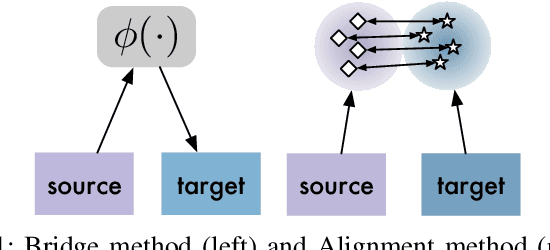
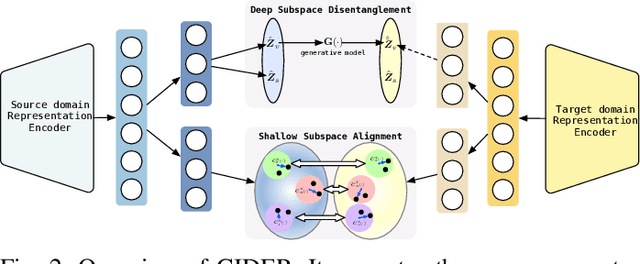

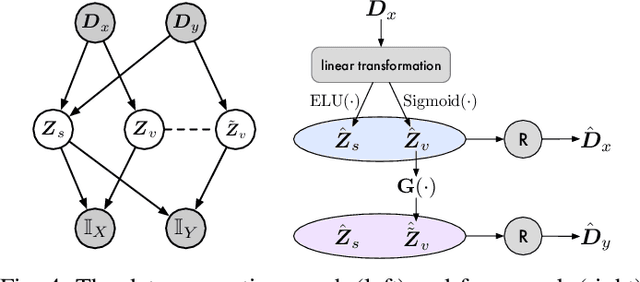
Abstract:Recent cross-domain recommendation (CDR) studies assume that disentangled domain-shared and domain-specific user representations can mitigate domain gaps and facilitate effective knowledge transfer. However, achieving perfect disentanglement is challenging in practice, because user behaviors in CDR are highly complex, and the true underlying user preferences cannot be fully captured through observed user-item interactions alone. Given this impracticability, we instead propose to model {\it joint identifiability} that establishes unique correspondence of user representations across domains, ensuring consistent preference modeling even when user behaviors exhibit shifts in different domains. To achieve this, we introduce a hierarchical user preference modeling framework that organizes user representations by the neural network encoder's depth, allowing separate treatment of shallow and deeper subspaces. In the shallow subspace, our framework models the interest centroids for each user within each domain, probabilistically determining the users' interest belongings and selectively aligning these centroids across domains to ensure fine-grained consistency in domain-irrelevant features. For deeper subspace representations, we enforce joint identifiability by decomposing it into a shared cross-domain stable component and domain-variant components, linked by a bijective transformation for unique correspondence. Empirical studies on real-world CDR tasks with varying domain correlations demonstrate that our method consistently surpasses state-of-the-art, even with weakly correlated tasks, highlighting the importance of joint identifiability in achieving robust CDR.
Bayesian-guided Label Mapping for Visual Reprogramming
Oct 31, 2024



Abstract:Visual reprogramming (VR) leverages the intrinsic capabilities of pretrained vision models by adapting their input or output interfaces to solve downstream tasks whose labels (i.e., downstream labels) might be totally different from the labels associated with the pretrained models (i.e., pretrained labels). When adapting the output interface, label mapping methods transform the pretrained labels to downstream labels by establishing a gradient-free one-to-one correspondence between the two sets of labels. However, in this paper, we reveal that one-to-one mappings may overlook the complex relationship between pretrained and downstream labels. Motivated by this observation, we propose a Bayesian-guided Label Mapping (BLM) method. BLM constructs an iteratively-updated probabilistic label mapping matrix, with each element quantifying a pairwise relationship between pretrained and downstream labels. The assignment of values to the constructed matrix is guided by Bayesian conditional probability, considering the joint distribution of the downstream labels and the labels predicted by the pretrained model on downstream samples. Experiments conducted on both pretrained vision models (e.g., ResNeXt) and vision-language models (e.g., CLIP) demonstrate the superior performance of BLM over existing label mapping methods. The success of BLM also offers a probabilistic lens through which to understand and analyze the effectiveness of VR. Our code is available at https://github.com/tmlr-group/BayesianLM.
Sample-specific Masks for Visual Reprogramming-based Prompting
Jun 05, 2024



Abstract:Visual reprogramming (VR) is a prompting technique that aims to re-purpose a pre-trained model (e.g., a classifier on ImageNet) to target tasks (e.g., medical data prediction) by learning a small-scale pattern added into input images instead of tuning considerable parameters within the model. The location of the pattern within input samples is usually determined by a pre-defined mask shared across all samples. In this paper, we show that the shared mask potentially limits VR's generalization and increases its approximation error due to the lack of sample-level adaptation. Motivated by this finding, we design a new framework for VR called sample-specific multi-channel masks (SMM). Specifically, SMM employs a lightweight ConvNet and patch-wise interpolation to generate sample-specific three-channel masks instead of a shared and pre-defined mask. Since we generate different masks for individual samples, SMM is theoretically shown to reduce approximation error for the target tasks compared with existing state-of-the-art VR methods. We also empirically demonstrate its performance gain on both ResNet and ViT. The success of SMM further highlights the broader applicability of VR in leveraging the latent knowledge of pre-trained models for various target tasks. Our code is available at https://github.com/tmlr-group/SMM.
Joint Identifiability of Cross-Domain Recommendation via Hierarchical Subspace Disentanglement
Apr 06, 2024
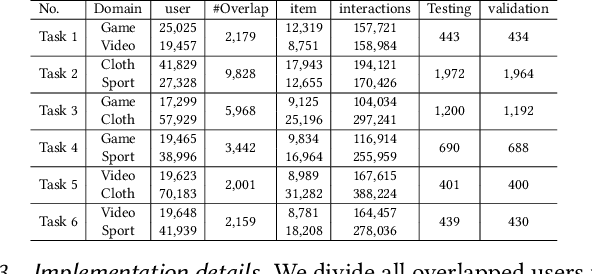
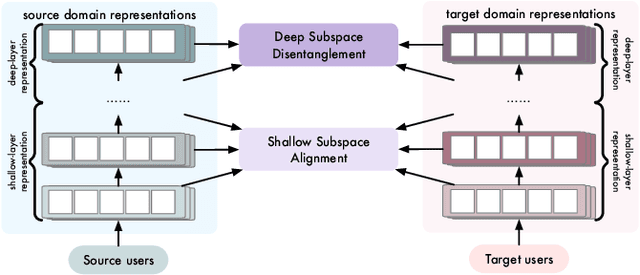
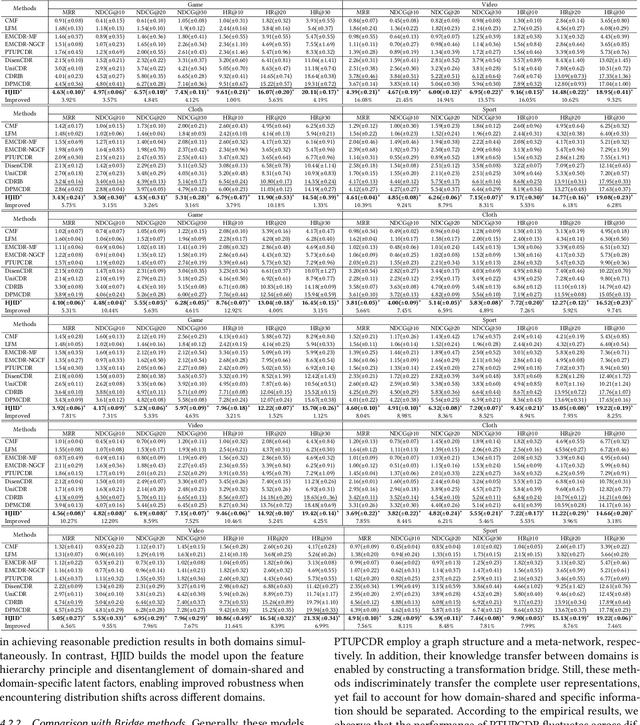
Abstract:Cross-Domain Recommendation (CDR) seeks to enable effective knowledge transfer across domains. Existing works rely on either representation alignment or transformation bridges, but they struggle on identifying domain-shared from domain-specific latent factors. Specifically, while CDR describes user representations as a joint distribution over two domains, these methods fail to account for its joint identifiability as they primarily fixate on the marginal distribution within a particular domain. Such a failure may overlook the conditionality between two domains and how it contributes to latent factor disentanglement, leading to negative transfer when domains are weakly correlated. In this study, we explore what should and should not be transferred in cross-domain user representations from a causality perspective. We propose a Hierarchical subspace disentanglement approach to explore the Joint IDentifiability of cross-domain joint distribution, termed HJID, to preserve domain-specific behaviors from domain-shared factors. HJID organizes user representations into layers: generic shallow subspaces and domain-oriented deep subspaces. We first encode the generic pattern in the shallow subspace by minimizing the Maximum Mean Discrepancy of initial layer activation. Then, to dissect how domain-oriented latent factors are encoded in deeper layers activation, we construct a cross-domain causality-based data generation graph, which identifies cross-domain consistent and domain-specific components, adhering to the Minimal Change principle. This allows HJID to maintain stability whilst discovering unique factors for different domains, all within a generative framework of invertible transformations that guarantee the joint identifiability. With experiments on real-world datasets, we show that HJID outperforms SOTA methods on a range of strongly and weakly correlated CDR tasks.
Distributional Domain-Invariant Preference Matching for Cross-Domain Recommendation
Sep 04, 2023Abstract:Learning accurate cross-domain preference mappings in the absence of overlapped users/items has presented a persistent challenge in Non-overlapping Cross-domain Recommendation (NOCDR). Despite the efforts made in previous studies to address NOCDR, several limitations still exist. Specifically, 1) while some approaches substitute overlapping users/items with overlapping behaviors, they cannot handle NOCDR scenarios where such auxiliary information is unavailable; 2) often, cross-domain preference mapping is modeled by learning deterministic explicit representation matchings between sampled users in two domains. However, this can be biased due to individual preferences and thus fails to incorporate preference continuity and universality of the general population. In light of this, we assume that despite the scattered nature of user behaviors, there exists a consistent latent preference distribution shared among common people. Modeling such distributions further allows us to capture the continuity in user behaviors within each domain and discover preference invariance across domains. To this end, we propose a Distributional domain-invariant Preference Matching method for non-overlapping Cross-Domain Recommendation (DPMCDR). For each domain, we hierarchically approximate a posterior of domain-level preference distribution with empirical evidence derived from user-item interactions. Next, we aim to build distributional implicit matchings between the domain-level preferences of two domains. This process involves mapping them to a shared latent space and seeking a consensus on domain-invariant preference by minimizing the distance between their distributional representations therein. In this way, we can identify the alignment of two non-overlapping domains if they exhibit similar patterns of domain-invariant preference.
Adversarially Contrastive Estimation of Conditional Neural Processes
Mar 23, 2023



Abstract:Conditional Neural Processes~(CNPs) formulate distributions over functions and generate function observations with exact conditional likelihoods. CNPs, however, have limited expressivity for high-dimensional observations, since their predictive distribution is factorized into a product of unconstrained (typically) Gaussian outputs. Previously, this could be handled using latent variables or autoregressive likelihood, but at the expense of intractable training and quadratically increased complexity. Instead, we propose calibrating CNPs with an adversarial training scheme besides regular maximum likelihood estimates. Specifically, we train an energy-based model (EBM) with noise contrastive estimation, which enforces EBM to identify true observations from the generations of CNP. In this way, CNP must generate predictions closer to the ground-truth to fool EBM, instead of merely optimizing with respect to the fixed-form likelihood. From generative function reconstruction to downstream regression and classification tasks, we demonstrate that our method fits mainstream CNP members, showing effectiveness when unconstrained Gaussian likelihood is defined, requiring minimal computation overhead while preserving foundation properties of CNPs.
Uncertainty-Aware Pedestrian Trajectory Prediction via Distributional Diffusion
Mar 15, 2023



Abstract:Tremendous efforts have been devoted to pedestrian trajectory prediction using generative modeling for accommodating uncertainty and multi-modality in human behaviors. An individual's inherent uncertainty, e.g., change of destination, can be masked by complex patterns resulting from the movements of interacting pedestrians. However, latent variable-based generative models often entangle such uncertainty with complexity, leading to either limited expressivity or overconfident predictions. In this work, we propose to separately model these two factors by implicitly deriving a flexible distribution that describes complex pedestrians' movements, whereas incorporating predictive uncertainty of individuals with explicit density functions over their future locations. More specifically, we present an uncertainty-aware pedestrian trajectory prediction framework, parameterizing sufficient statistics for the distributions of locations that jointly comprise the multi-modal trajectories. We further estimate these parameters of interest by approximating a denoising process that progressively recovers pedestrian movements from noise. Unlike prior studies, we translate the predictive stochasticity to the explicit distribution, making it readily used to generate plausible future trajectories indicating individuals' self-uncertainty. Moreover, our framework is model-agnostic for compatibility with different neural network architectures. We empirically show the performance advantages of our framework on widely-used benchmarks, outperforming state-of-the-art in most scenes even with lighter backbones.
 Add to Chrome
Add to Chrome Add to Firefox
Add to Firefox Add to Edge
Add to Edge